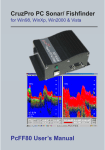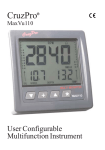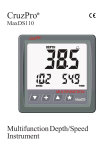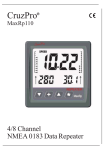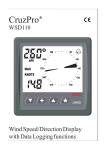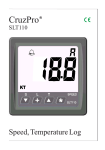Download Basic Marine Electrics and Troubleshooting
Transcript
Basic Marine Electrics and Troubleshooting Rob Starkey [email protected] May 2010 Copyright © R Starkey 2010 Version 5.0 Agenda A few bootstrap terms to get started Managing expectations Battery fundamentals Charging batteries Introduction to marine 12 volt circuits Basic marine 12 volt systems Troubleshooting marine 12 volt systems Battery Management Copyright © R Starkey 2010 Slide 2 First a few electrical terms Voltage (V) • The pressure of the circuit, without pressure there is no output! Current (I) • You increase voltage (pressure) to increase the current flowing measured in amps Power (P) • The work being done, measured in watt (Power = voltage x current) Ampere‐hours (Ah) Copyright © R Starkey 2010 • The amount of current (amps) a battery will delivery and the time (hours) it delivers the current (Ah=current x Hrs) Slide 3 First a few electrical terms Battery Starting battery • A source of electrical energy • The battery for starting or cranking engines (Cranking battery) House battery • The battery providing electrical loads when the engine is not running (Deep cycle battery) Rate of discharge Rate of charge • 20 amp load for ½ hour reduces your battery by 10 Ah State of charge • Indication of available battery capacity measured in percent (fully charged = 100%) Copyright © R Starkey 2010 Slide 4 Agenda A few bootstrap terms to get started Managing expectations Battery fundamentals Charging batteries Introduction to marine 12 volt circuits Basic marine 12 volt systems Troubleshooting marine 12 volt systems Battery Management Copyright © R Starkey 2010 Slide 5 Managing Expectations 2 What battery capacity do I require? Charge Discharge 1 How much electrical energy do I consume? Copyright © R Starkey 2010 3 What charge current and charge time do I require? Slide 6 Managing expectations 3 questions you should be able to answer Consumption (all scenarios) (1) How much electrical energy do I consume? Battery capacity (2) What battery capacity do I require to support my consumption? How to charge batteries (3) What charge type, charge current and charge time do I require? Copyright © R Starkey 2010 Slide 7 1 Consumption per cycle Four simple steps to determine electrical consumption 1) List all 12 volt electrical appliances and quantity 3) Estimate the time in hours each appliance will be used per discharge cycle. 4) Calculate Ah Amp/hours. Amp/hours = quantity * amperage * hours 2) Determine the amount of current each appliance uses Amps = Watts/Volts 72 watts/12 volts = 6.0 amps (1) Appliance (1) Quantity (2) Current (amps) (3) Time Used (Hrs) (4) Daily Total (Ah) (4) Total (Ah) Cabin lights Cabin lights 8 8 1.5 A 1.5 A 1.0 Hrs 1.0 Hrs 12 Ah VHF (receive) VHF (receive) 1 1 0.3 A 0.3 A 24 Hrs 24 Hrs 7 Ah Fresh water pump Fresh water pump 1 1 2.5 A 2.5 A 0.5 Hrs 0.5 Hrs 1 Ah Navigation lights Navigation lights 3 3 0.9 A 0.9 A 12.0 Hrs 12.0 Hrs 11 Ah Refrigerator 1 1 6.0A 24/3 Hrs 48Ah Total daily Amp‐Hours Total Amp‐Hours (Ah) usage per discharge cycle Copyright © R Starkey 2010 79 Ah Slide 8 Typical appliance loads 12 Volt Appliance Amps (typical) 12 Volt Appliance Amps (typical) Anchor Light 2.0 GPS 0.5 – 1.0 Anchor light (LED) 0.25 Log 0.1 Anchor windlass 40‐300 Masthead (incandescent) 2.0 Autopilot standby (drive) 1 (30) Radar 4.0 – 8.0 Bilge blower 2.5 Refrigerator 5.0 ‐8.0 Bilge pump 5.0 Navigation lights 2.5 Cabin fan 0.2 – 1.0 Spotlight 10.0 Cabin lights (incandescent) 1.5 – 3.5 Deck lights 8.0 Cabin lights (halogen) 1.6 – 2.0 HF radio RX (TX) 2.0 (25 ‐35) Cabin lights (LED) 0.3 VHF radio RX (TX) 1.0 (5.0 ‐6.0) Fluorescent light 0.7 – 1.8 Stereo HiFi 1.0 Depth sounder 0.1 – 0.5 Instrument slave (each) 0.1 Fresh water pump 5.0 Instrument master 0.3 – 1.0 Copyright © R Starkey 2010 Slide 9 Agenda A few bootstrap terms to get started Managing expectations Battery fundamentals Charging batteries Introduction to marine 12 volt circuits Basic marine 12 volt systems Troubleshooting marine 12 volt systems Battery Management Copyright © R Starkey 2010 Slide 10 Some battery facts A battery does not store electrical energy, it converts chemical energy into electrical energy by electrochemical reaction You shorten the specified life of your battery by undercharging and conversely by overcharging Specified battery life is shortened by discharging below 50% of capacity Batteries are inefficient, you need to replace 10% to 20% additional amp‐ hours to recharge your batteries The voltage difference between a fully charged and fully discharged battery is approximately 1.0 volt (12.6 v to 11.6v). Copyright © R Starkey 2010 Slide 11 More battery facts The greater the discharge rate, the less battery capacity available • 100Ah battery discharging at 65A for 1 hour will exhaust battery providing 65Ah • 100Ah battery discharging at 5A for 20 hours will provide 100Ah A deeply discharged battery struggles supplying power to high amperage device, however may supply sufficient power to a low amperage device • Open circuit voltage of 12.5 Volts • Starter Motor 11.09 volts • Light bulb 12.49 volts • Open circuit voltage of 12.0 Volts • Starter Motor 10.00 volts • Light bulb 11.90 volts Copyright © R Starkey 2010 231 amp 1 amp 2562 watts 12.5 watts 200 amp 1 amp 2000 watts (‐22%) 11.9 watts (‐5%) Slide 12 More battery facts When charging a battery, the charge voltage must be higher than the fully charged voltage, typically 13.8 to 14.0 volts • Greater the voltage difference between charge device and battery, greater the charge current A deeply discharged battery can absorb as much as 30% of its capacity, until it starts gassing (14.4 volts) • 10% charge rate, reaches gassing voltage at 8 hours and will be 85% charged • 40% charge rate, reaches gassing voltage at 1.3 hours and will be 55% charged The most practical charging rate for a quick recharge is 20% to 30% of the battery capacity until it reaches the gassing voltage Copyright © R Starkey 2010 Slide 13 More battery facts A battery accepts more charge amps at 50% discharge than at 25% discharge • Battery acceptance rate tapers to just a few amps as it approaches fully charged. • A 100 Ah battery at 50% capacity, accepts 17 amps • The same battery at 75% capacity, accepts 7 amps The charge time from 50% to 80% is much shorter than the time it takes from 80% to fully charged Copyright © R Starkey 2010 Slide 14 (Q2) What battery capacity Discharging your battery below 50% will significantly shorten it’s specified life expectancy • 50% capacity should be your operational discharge limit Copyright © R Starkey 2010 The charge rate of a battery decreases above 80% of charge Therefore the efficient capacity of a battery is 30% of its Ah capacity. • For a 100Ah battery, 17A at 50% and 7A at 75% • Both time and cost to charge double above 80% • For a 100 Ah battery you should only budget on 30 Ah discharge before recharging. Battery capacity (Ah), needs to be at least three (3) times your usage between charges Slide 15 Battery fundamentals What type of battery is best suited for my type of sailing, what performance should I expect and what additional battery facts should I be aware of? • • • • • • The basic battery Battery types, (applications & construction) Understanding battery ratings Life expectancy Connecting batteries Battery maintenance Copyright © R Starkey 2010 Slide 16 Galvanic series table (salt water) Metals and alloys Range in Volts Zinc ‐0.98 ‐1.03 Aluminum Alloys ‐0.76 ‐1.0 Cadmium ‐0.70 ‐0.73 Mild Steel ‐0.60 ‐0.71 Stainless Steel Type 410 (active) ‐0.46 ‐0.58 Stainless Steel Type 316 (active) ‐0.43 ‐0.54 Naval Brass ‐0.30 ‐0.40 Copper ‐0.30 ‐0.57 Lead Tin Solder ‐0.28 ‐0.37 Admiralty Brass ‐0.28 ‐0.36 Silicone Bronze ‐0.26 ‐0.29 Stainless Steel Type 401 (passive) ‐0.26 ‐0.35 Stainless Steel Type 316 (passive) ‐0.00 ‐0.10 Copyright © R Starkey 2010 Aluminum Stainless steel joints in salt water produce 0.66 to 1.0 Volts Slide 17 The basic battery - + Discharge + Charge Decreasing Acid Increasing Acid Increasing Water Decreasing Water Decreasing Sponge Lead Decreasing Lead Oxide Increasing Sponge Lead Increasing Lead Oxide Increasing Lead Sulfate Increasing Lead Sulfate Decreasing Lead Sulfate Decreasing Lead Sulfate • A battery does not store electrical energy, it converts chemical energy into electrical energy by electrochemical reaction. • For a lead acid battery, the fully charged voltage of each cell is 2.1 volts • A 12 volt battery consists of 6 cells. The battery terminal voltage will be 12.6 volts (6 x 2.1) when fully charged Copyright © R Starkey 2010 Note: Arrows show electron flow not current flow Fully charged cell specific gravity 1.265 to 1.300 depending on temperature Slide 18 Construction & Application Construction Application Flooded Gel Cranking AGM Deep Cycle Lithium Copyright © R Starkey 2010 Slide 19 Battery applications Cranking • High current for short periods and rarely deeply discharged • Small thin plates producing very high current for short bursts • Begin failing after 50 cycles of greater than 50% discharge Deep‐cycle batteries • Moderate current for long periods with many discharge cycles • Rugged, thick plates • Expect up to 1,000 cycles for a quality deep‐cycle battery Copyright © R Starkey 2010 Slide 20 Battery Construction Flooded Maintenance free (sealed flooded) Gel (electrolyte is gelled) Absorbed Glass Matt (AGM) Copyright © R Starkey 2010 Slide 21 Flooded Batteries The traditional battery construction consisting of lead and lead oxide plates immersed in a liquid electrolyte of sulfuric acid and water. Often used as automotive starting batteries and some deep cycle batteries such as Golf Cart batteries Require continuous maintenance to monitor and replenish evaporated water following loss of hydrogen and oxygen Copyright © R Starkey 2010 Slide 22 Maintenance Free Batteries A maintenance free version of the flooded cell, has hardened plates to reduce water loss during charging. This plate hardening raises internal resistance preventing rapid charging, therefore lower acceptance rate With the battery sealed, it is impossible to check electrolyte levels or measure specific gravity. If subjected to excessive charging, the electrolyte will boil off causing premature failure Copyright © R Starkey 2010 Slide 23 Gel Batteries A sealed battery with a gel electrolyte rather than liquid as found in the flooded cell. Because they are sealed their construction and chemistry is intended to significantly reduce gassing. This battery must not be allowed to gas. While they will accept high charging currents they are v e r y s e n s i t i v e t o h i g h c h a r g i n g voltages. Gel batteries must not be charged above 14.1 volts or they will be destroyed. Normal flooded batteries charge at 14.4 volts. Copyright © R Starkey 2010 Slide 24 Absorbed Glass Matt Batteries Similar construction to gel, sealed, and can be installed on their side. Some consist of soft thin rolled up plates (Optima) resulting in greatly improved resistance to vibration. AGMs have very low internal resistance and can therefore accept very high charge rates, high acceptance rate. Maintain a higher terminal voltage during discharge making them more suited for large inverters and sensitive electronics. As they are not sensitive to charge voltages, standard constant rate charges can be used. Copyright © R Starkey 2010 Slide 25 Understanding battery ratings specific to application Cranking – C C A , C o l d C ra n k i n g A m p s • Is the maximum discharge a 12 volt battery can deliver for 30 seconds at 0oF • 525 CCA x 0.5 minutes = 262.5 amp‐minutes divided by 60 minutes is 4.3 Ah – C C P, C o l d C ra n k i n g Po w e r • Same as CCA – M C A , M a r i n e C ra n k i n g A m p s • Same formula as CCA except rated at 32oF Higher the CCA or MCA the better for cranking Copyright © R Starkey 2010 Slide 26 Understanding battery ratings specific to application Deep Cycle – Re s e r ve C a p a c i t y sometimes called Peak Capacity • • Time a battery can supply 25 amps at 80oF to an end point of 10.5 volts Reserve capacity of 160 minutes x 25 amps = 4000 amp minutes or 66.6 Ah – A m p ‐ h o u r rate (20 hour rate) • • Amps required to drain a battery to 10.5 volts over a period of 20 hours at 80oF A battery rated at 100Ah is capable of delivering 5 amps for 20 hours, or 10 amps at 10 hours Copyright © R Starkey 2010 Slide 27 Life expectancy it’s all about cycles Battery Life Cycles (50%) When purchasing deep cycle batteries it is important to know the life expectancy in cycles A battery completes one cycle when it is discharged and then fully charged The number of cycles depends on the depth of discharge, rate of charge, the recharge method and quality of the battery When purchasing deep cycle batteries, compare cost per specified cycle in addition to battery price Copyright © R Starkey 2010 Type Cycles Cranking 25 – 50 Flooded deep cycle 250 – 350 Gel 500 6 volt Golf cart 700 High quality AGM 900 ‐ 1700 Actual AGM estimated cycle life 4,000 cycles @ 10% DOD 3,800 cycles @ 20% DOD 3,500 cycles @ 30% DOD 2,500 cycles @ 50% DOD 1,500 cycles @ 80% DOD Slide 28 Connecting Batteries Batteries in series 6 volts - - 200 Ah • Increase voltage by connecting batteries in series, connect positive of one to the negative of the other • Two 6 volt 200 Ah batteries in series will yield one 12 volt 200 Ah battery configuration 200 Ah 12 volts - Copyright © R Starkey 2010 200 Ah 12 volts Batteries in parallel • Increase amp‐hours (Ah) by connecting batteries in parallel, connect the positive terminals of two or more batteries and also the negative terminals of two or more batteries • Two 12 volt 100 Ah batteries in parallel will yield one 12 volt 200 Ah battery configuration 6 volts + 100 Ah 12 volts - + + 100 Ah 12 volts 200 Ah Slide 29 + Connecting batteries 1. Make sure the same current flows through each battery – Current will follow the path of least resistance 2. Do not combine old with new 3. Do not combine unlike chemistries 12 volts - 12 volts - 12 volts + - 100 Ah 12 volts + 100 Ah - 12 volts 200 Ah 200 Ah Copyright © R Starkey 2010 + 100 Ah 12 volts + 100 Ah Slide 30 Battery maintenance Wet cell batteries must be periodically topped up with distilled water and specific gravity recorded Keep tops of batteries clean, especially the terminals Periodically remove battery connections clean the terminals and reconnect Always keep batteries at full charge when not in use Regularly monitor the battery voltage, especially during charge cycles on any form of sealed battery Copyright © R Starkey 2010 Slide 31 Agenda A few bootstrap terms to get started Managing expectations Battery fundamentals Charging batteries Introduction to marine 12 volt circuits Basic marine 12 volt systems Troubleshooting marine 12 volt systems Battery Management Copyright © R Starkey 2010 Slide 32 Charging batteries the 3rd question “Each morning I find my batteries • “I thought I fixed the problem by adding are heavily discharged, they batteries and yet a week later I find the appear to have less and less batteries are in a discharged state again” charge available”. If we have matched our battery capacity with daily electrical requirements, Ah = 3 times daily usage, then we have a charge rate ( amps and or time) issue. (a) what charge device/s (b) what charge current and (c) how long? (a) Devices (b) Current (c) Time Alternators and their regulators Copyright © R Starkey 2010 240 volt battery chargers Solar panels Wind generators Slide 33 Alternators Alternators are an inexpensive and reliable method of charging batteries, mass produced, every car and truck has one, most boats have at least one sometimes two. There are automotive and marine versions. Marine versions are continuously rated, sometimes fully enclosed, always with a negative power stud, so does not rely on the engine block for return current. Copyright © R Starkey 2010 Slide 34 Alternator output • Assume Balmar 110 Amp alternator with 1 to 3 pulley ratio – Alternator turns 3 revolutions for every 1 engine revolution • At 800 rpm (engine) this alternator will provide 75 amps • While at 2,000 rpm (engine) this alternator will provide the rated output of 110 amps Copyright © R Starkey 2010 Slide 35 Alternators • • • • Copyright © R Starkey 2010 They work by passing a rotating field (field winding) over a stationary winding (stator windings). A variable current in the rotating field winding of approximately 1 amp will produce up to 100 amps in the stationary windings. The variable field current is controlled by the regulator, thereby controlling the alternator output voltage. The output from the stationary windings is alternating current, and is converted into direct current (DC) by a diode rectifier. Slide 36 Constant voltage regulator Automobile Regulators • The alternator, not the battery provides energy to vehicle electrical system with engine running • Designed to provide large current initially and reduce current as voltage increases • Avoids overcharging, gassing of hydrogen and oxygen Known as a constant voltage regulator Great for cranking batteries, very bad for deep cycle batteries 100 14 100 13 75 12 50 11 25 10 9 Discharging Charging Time Copyright © R Starkey 2010 0 Ah Amperage% Volts 15 80 60 40 20 11 11.5 12 12.5 Volts 13 13.5 Slide 37 14 Alternator with smart regulator Standard alternator with smart regulator makes a very efficient charge device • Internal constant voltage regulator replaced with external smart regulator • Provides bulk, absorption and float charge phases • Constant current in bulk phase reduces charge time to less than 1/4 of constant voltage regulator Copyright © R Starkey 2010 + Brush B+ Stator Windings To Tachometer Field Windings Brush To battery positive W + Field terminal - F B- Voltage Regulator F 12V On 0V 0VDC Reg on 12VDC Slide 38 Multi stage regulator Bulk Charge Absorption Charge Float Charge 14.1 – 14.4 volts 100% 14 13.2 – 13.6 volts Volts 13 75% 12 11 Constant current charge at rated output until absorption voltage is reached 10 Absorption charge at constant voltage for specific time or until current absorbed by battery falls to threshold level (<4%) Time Copyright © R Starkey 2010 Float charge at a constant voltage 50% 25% Percentage of chargers rated output (amps) 15 0% Slide 39 240 Volt AC battery chargers • 240 Volt AC multi‐stage battery chargers provide a constant charge current, 50 amp means 50 amps when in bulk charge phase • Ideally suited for deep cycle batteries (flooded, gel and AGM) • Suited for charging at marinas and where on board 240 volt AC generation is available • Sometimes integrated with large inverters Copyright © R Starkey 2010 Slide 40 Solar Panels • Each cell generates about 0.45 to 0.5 volts so 32 cells are required to charge a 12 volt battery (14 to 16 volts) • Solar panel must be at 90o to the sun for maximum output, a shadow can reduce output as much as 60% • Prime sunlight is 9:30 am through 3:00 pm, 6 hours per day • At 3 to 7 amps an hour for 6 hours per day, typically 18 Ah to 42 Ah, so not a bulk charge device • They are very good float charge devices preventing self discharge during unattended periods Copyright © R Starkey 2010 Slide 41 Wind generators • Dependent on wind strength, marginal in many areas, very good in trade wind areas (10knts ‐ 1.6A, 29knts ‐ 9.5 A) • In consistent wind areas can produce up to 150Ah per day, so a viable charge option • Selection should be based on output and noise level! Copyright © R Starkey 2010 Slide 42 Q3 Charging your batteries? There are three parts to the question; What charge current? 25% to 30% of your battery capacity plus your average usage in amps is the most efficient charge current (can be increased with high acceptance rate batteries, AGM) The most efficient charge strategy is a multi stage charger combination of alternator and mains charger. If you discharge to 50% of battery capacity and recharge to 85%, you need to replace 35% of battery capacity plus inefficiencies (10%) Copyright © R Starkey 2010 What devices should I use? How long do I charge? • Assume battery capacity 200Ah and average current drain 5 amps • 30% of 200Ah = 60 amps plus average current of 5 amps = 65 amps • You require a charge system of approximately 65 amp • Alternator/s (smart regulator) • Gensets with 240 volt AC charger • Wind and solar can be treated as incremental • 35% x 110% = 39% of battery Ah divided by charge current is the charge time • Scenario above, charge time = (39% x 200Ah/60 amps) = 1.3 hour Slide 43 Agenda A few bootstrap terms to get started Managing expectations Battery fundamentals Charging batteries Introduction to marine 12 volt circuits Basic marine 12 volt systems Troubleshooting marine 12 volt systems Battery Management Copyright © R Starkey 2010 Slide 44 Understanding electrical circuits What are the parameters of a 12 volt circuit? How do I measure these parameters and how do I apply them to the diagnosis of a 12 volt system? 1. 2. 3. 4. 5. The water tank analogy Ohm’s law (current, voltage and resistance) Diagnostic instruments Measuring volts Basic electrical circuits (series circuits, parallel circuits and circuits that bypass control switches) Copyright © R Starkey 2010 Slide 45 Water tank analogy Electricity has three parameters: Voltage, Current and Resistance Voltage – A force (voltage) pushing the electrical current (electrons) against an opposition or resistance, the load plus cable and connector resistance – Voltage is the unit of measure of potential difference (symbol V) – In the water analogy, the force is a head of water, pushing against a closed valve High Potential Low Potential (excess of water) (empty of water) Closed valve Copyright © R Starkey 2010 Slide 46 Water tank analogy Current – Is the flow of free electrons past a point in the circuit – Ampere (amp) is the unit of measure of flow rate (symbol I) Resistance – The opposition to flow of electricity is called resistance, unit of measure is ohm, (symbol R) – All material in a circuit provides resistance to the current In the water analogy, head of water is the Voltage, water flow rate is Current, valve and pipe present Resistance High Potential Low Potential (excess of water) (low water level) Partly opened valve Copyright © R Starkey 2010 Slide 47 Ohm’s Law • A mathematical relationship exists between the amount of voltage, current and resistance in an electrical circuit V (volts) = I (amperes) x R (ohms) • It takes one volt of applied pressure to move one ampere of electrical current against one ohm of resistance 1 volt of force 1 ohm of resistance 1 amp of current (electrons) • Ohm’s law can be written in several different forms: I = V/R • R = V/I V=IxR Power, measured in watts is the work being done or the pressure times the current being passed Power = Voltage times Current, P = V x I (746 W = 1HP) Copyright © R Starkey 2010 Slide 48 Diagnostic instruments You can only see electricity in the form of lightning and sparks, feel it when shocked, so an instrument is required to troubleshoot electrical circuits. – The multimeter is the most common instrument and is used to measure, amps, volts and ohms (AVO) – Tong meters are excellent ammeters however only as a supplement to multimeters – A test lamp can be used to measure voltage Copyright © R Starkey 2010 Slide 49 Multimeter selection options Volts Dc and Volts AC Current Dc and Resistance Current AC Current connections Continuity Voltage & continuity connections Copyright © R Starkey 2010 Slide 50 Basic marine electrical circuits Series circuit • Think of it as a circle • A break anywhere will interrupt current flow Copyright © R Starkey 2010 Slide 51 Basic marine electrical circuits Parallel circuits • A set of series circuits with common paths • Makes for easier troubleshooting • Think of each circuit as a circle Copyright © R Starkey 2010 Slide 52 Basic marine electrical circuits 12 V Panel 24 Hour Circuits • Emergency and standby circuits that bypass the main switch • Bilge pumps, appliances with stored parameters, shoreGround based battery chargers, etc. Main Switch Main Cabin Breaker Lights Forward Switch Aft Switch Fuse Main Switch Nav Lights Battery Port Switch Starboard Stern Shunt 12V Neg Bus Water Pressure Switch P Pressure Pump Bilge Pump Switch P Bilge Pump Float Switch • Just another circle with different controls Copyright © R Starkey 2010 Panel 12 V Neg Bus Slide 53 Agenda A few bootstrap terms to get started Managing expectations Battery fundamentals Charging batteries Introduction to marine 12 volt circuits Basic marine 12 volt systems Troubleshooting marine 12 volt systems Battery Management Copyright © R Starkey 2010 Slide 54 Basic marine 12 volt systems What are the basic components of a marine electrical system? What are the functions of these components and how do I identify them? Understanding these questions is a prerequisite to diagnosing your 12 volt system. • • • • • Basic marine 12 volt system scenarios Cranking (starting) circuit Charging circuit Battery combiners House circuit Copyright © R Starkey 2010 Slide 55 Basic 12 marine volt system scenarios One battery for starting and house (battery must be deep cycle) Copyright © R Starkey 2010 Slide 56 Basic marine 12 volt system scenarios One start (cranking) battery, one (deep cycle) house battery Copyright © R Starkey 2010 Slide 57 Basic marine 12 volt system scenarios One start battery, dual house batteries BF B+ W With battery select switch (off, A or B, both) Alternator Regulator Ignition/Oil Pressure Panel Main Breaker Solenoid Circuit 3 Circuit 4 C A Switch House A Master Ground Copyright © R Starkey 2010 Load 1 Load 2 Load 3 Load 4 Panel 12 V Neg Off, A, B, Both Starter Motor Start Circuit 1 Circuit 2 B House B Main 12 V Neg Slide 58 The cranking circuit BF B+ W Alternator Regulator Ignition/Oil Pressure Panel Main Breaker Solenoid Circuit 3 Circuit 4 C A House A Start Master Ground Copyright © R Starkey 2010 Switch Load 1 Load 2 Load 3 Load 4 Panel 12 V Neg Off, A, B, Both Starter Motor Start Circuit 1 Circuit 2 B House B Main 12 V Neg Slide 59 The charging circuit BF B+ W Wind Alternator Solar Regulator Ignition/Oil Pressure Panel Main Breaker Solenoid Circuit 3 Circuit 4 C A Starter Motor House A Master Ground Copyright © R Starkey 2010 Switch Load 1 Load 2 Load 3 Load 4 Panel 12 V Neg Off, A, B, Both Start Circuit 1 Circuit 2 B House B Main 12 V Neg Slide 60 Charging circuit (alternate) Copyright © R Starkey 2010 Slide 61 Battery combiner (diode) Copyright © R Starkey 2010 Slide 62 Battery combiner (solenoid) Activates when engine is operating Copyright © R Starkey 2010 Slide 63 Battery combiner (ACR) Automatic, on when charge voltage detected, off when load is detected Copyright © R Starkey 2010 Slide 64 House circuit Copyright © R Starkey 2010 Slide 65 House circuit detail 12 V Panel Main Switch Main Cabin Breaker Lights Forward Switch Aft Switch Fuse Main Switch Nav Lights Battery Port Switch Starboard Stern Shunt 12V Neg Bus Ground Water Pressure P Pressure Pump Bilge Pump P Bilge Pump Float Switch Panel 12 V Neg Bus Copyright © R Starkey 2010 Slide 66 Agenda A few bootstrap terms to get started Managing expectations Battery fundamentals Charging batteries Introduction to marine 12 volt circuits Basic marine 12 volt systems Troubleshooting marine 12 volt systems Battery Management Copyright © R Starkey 2010 Slide 67 Troubleshooting 12 volt systems If you understand the capabilities of your 12 volt system, the components, and know your way around the basic circuit, you are ready to start troubleshooting your 12 volt system. 1. 2. 3. 4. 5. 6. 7. Basic troubleshooting Finding a break or open circuit Finding a short circuit Troubleshooting parallel circuits Troubleshooting charging circuits Troubleshooting batteries Troubleshooting alternators Copyright © R Starkey 2010 Slide 68 Basic troubleshooting Never leave port without a multimeter, test lamp and spares There are three fundamentals in locating any electrical fault: 12 V Panel 1. Establish a common starting position, such as the battery condition – – This provides a known reference to work from Voltage (the pressure in the circuit) is the most important measurement Main Switch Aft Main Switch Nav Lights Battery Port Switch Starboard Stern Shunt 12V Neg Bus Ground Water Pressure P Pressure Pump Bilge Pump P Bilge Pump Float Switch This will ensure you introduce only one unknown at each step 3. Slice the circuit into halves as you select consecutive test points, continue until fault located – Forward Switch Switch Fuse 2. Always maintain one common point of reference, example move one test lead at a time – Main Cabin Breaker Lights Panel 12 V Neg Bus This is the fastest way of searching through any set of unknowns Copyright © R Starkey 2010 Slide 69 Basic Troubleshooting Series circuit • Think of it as a circle • Without Voltage (Pressure) there is no current • A break anywhere will interrupt current flow • A short circuit will trip a circuit protection device (fuse or breaker) and possibly discharge batteries Copyright © R Starkey 2010 Slide 70 Troubleshooting parallel circuits Reduce the problem to a single circuit and eliminate common circuits components known to be operational. Where possible establish and use a common reference point. 12 V Panel Main Switch Main Cabin Breaker Lights Switch Aft Switch Fuse 3AG 3A Main Switch Nav Lights Battery Forward Port Switch Starboard Stern Shunt 12V Neg Bus Ground Water Pressure Switch P Pressure Pump Bilge Pump Switch P Bilge Pump Float Switch Copyright © R Starkey 2010 Panel 12 V Neg Bus Slide 71 Troubleshooting Batteries There are five ways to check the state of charge and or health of a battery In the case of wet cells, measure the specific gravity of the electrolyte Open‐circuit voltage test Perform a load test to determine if battery is capable of delivering high currents Perform a capacity test to determine the actual Ah capacity of your battery Monitor Volts, Amps and Ahr with an amp‐hour meter Copyright © R Starkey 2010 Slide 72 Troubleshooting batteries Specific gravity test • Measure and record the specific gravity of each cell • If cell readings vary by greater than 0.050 specific gravity or the lowest cell is less than 1.225, charge the battery • Charge the battery until all cells are greater than 1.225 specific gravity. If this is not achieved in all cells the battery has one or more defective cells, change the battery o o Approximate State of Charge (at 80 F, 26.7 C) Charged 1.225 Initial full charge 1.265 Initial full charge 1.280 Initial full charge 1.300 Initial full charge 100% 1.225 1.265 1.280 1.300 75% 1.185 1.225 1.240 1.255 50% 1.150 1.190 1.200 1.215 25% 1.115 1.155 1.170 1.180 Discharged 1.080 1.120 1.140 1.160 Copyright © R Starkey 2010 Slide 73 Troubleshooting batteries Open circuit voltage test If battery has been on charge, apply a heavy load for 30 seconds, disconnect the battery, allow to sit for 15 to 30 minutes and measure the terminal voltage. Open Circuit Voltage Percent Charge 12.6 plus 100% 12.45 – 12.6 75 - 100% 12.24 – 12.45 50 – 75% 12.06 – 12.24 25 – 50% 11.7 – 12.06 0 – 25% 11.7 or less 0% Copyright © R Starkey 2010 Slide 74 Troubleshooting batteries Load test A battery can show a full or nearly full charge on both an open‐circuit voltage test and a specific gravity test, yet fail to deliver high current. In this case the battery should be load tested. This test requires a specialized test device that loads the battery at 3 to 4 times its normal load for a 10 second period and measures the terminal voltage. If you suspect your battery is not delivering the specified load, have a professional perform a load test. Copyright © R Starkey 2010 Slide 75 Troubleshooting batteries Capacity test If you suspect your battery is not delivering the specified amp‐hours then you should run a capacity test. 1. 2. 3. 4. 5. 6. The battery is first brought to full charge The test start time is noted It is then discharged at 1/20th of its rated amp‐hour capacity (e.g., 10 amps on a 200Ah battery). The load is established by turning on the required number of incandescent lamps. Run the test until the battery terminal voltage falls to 1.75 volts per cell (10.5 volt for a 12 volt battery) Record the elapsed time and multiply the current by the elapsed time to give amp‐hours (Ah) The battery must be immediately recharged. You have now confirmed the Ah capacity of your battery. Copyright © R Starkey 2010 Slide 76 Troubleshooting batteries Battery fails to keep a charge • Fully charge the battery and record its open circuit voltage and specific gravity • Place it on open circuit for three days by disconnecting both battery cables • Measure the open circuit voltage and specific gravity – If voltage drops by greater than 0.20 volts or 35 specific gravity points (0.035) there is an internal short. – Replace the battery Copyright © R Starkey 2010 Slide 77 Troubleshooting alternators 1. 2. 3. 4. 5. 6. 7. Eliminate mechanical problems, loose belts etc. With alternator spinning, voltage at battery should be > 12.6 volts If battery voltage <=12.6, alternator not charging Check, regulator +12v and “reg‐on”, both should be 12 volt, if not correct If regulator is turned on (4), disconnect field and connect 12 w lamp from alternator field to 12 volt If alternator voltage increases to >12.6 volt, faulty regulator If alternator voltage did not increase to >12.6 volt, fault alternator Balmar 614 Battery T F G 12V On Fuse Thermister +12 volt To Tachomoter Field Ground Fuse Ignition or oil pressure switch Caution: Never disconnect alternator B+ or B- when alternator is spinning, this will destroy alternator internal diodes Copyright © R Starkey 2010 Slide 78 Agenda A few bootstrap terms to get started Managing expectations Battery fundamentals Charging batteries Introduction to marine 12 volt circuits Basic marine 12 volt systems Troubleshooting marine 12 volt systems Battery Management Copyright © R Starkey 2010 Slide 79 Battery management What is your 12 volt battery state of charge? And how do you manage it? Specific gravity test (flooded batteries only) Open circuit voltage test (difficult because 1 volt difference between 100% and 0.0% charge) M o n i t o r c h a r g e c y c l e with voltage and current measurements (only possible with multi stage regulator) A m p ‐ h o u r b a t t e r y m a n a g e m e n t instrument (Recommended) Copyright © R Starkey 2010 Slide 80 Specific gravity test A p p r o x i m a t e s t a t e o f c h a r g e (at 80o F, 26.7 o C) Charged 1.225 1.265 1.280 1.300 Initial full charge Initial full charge Initial full charge Initial full charge 100% 1.225 1.265 1.280 1.300 75% 1.185 1.225 1.240 1.255 50% 1.150 1.190 1.200 1.215 25% 1.115 1.155 1.170 1.180 Discharged 1.080 1.120 1.140 1.160 Copyright © R Starkey 2010 Slide 81 Open circuit voltage test Open Circuit voltage 12.6 plus Percent charge 100% 12.45 – 12.6 75% – 100% 12.24 – 12.45 50% ‐ 75% 12.06 – 12.24 25% ‐ 50% 11.7 – 12.06 0 – 25% 11.7 or less 0% Apply moderate load for 15 minutes, disconnect battery, allow to sit for 15 minutes and measure terminal voltage Copyright © R Starkey 2010 Slide 82 Monitoring charge cycle 55% ‐ 80% dependent on absorption rate 15 Bulk Charge Absorption Charge 100% Float Charge 14.1 – 14.4 volts 14 13.2 – 13.6 volts Volts 13 12 11 Voltage increasing? 10 Voltage constant at ~14 volts? Voltage constant at ~ 13 volts? Time Copyright © R Starkey 2010 Slide 83 Amp‐hour battery management Copyright © R Starkey 2010 Slide 84 Battery management options CruzPro VAH60 CruzPro VAH65 CruzPro VAH60 Microlog DMM‐1 Xantrex Link 10 Banks 1 3 3 2 1 Display Volts, Amps, Ah Volts, Amps, Ah Volts, Amps, Ah Volts, Amps Volts, Amps, Ah 0.018 0.018 0.035 0.002 0.028 NEMA 183 Yes Yes Yes No No Warranty 1 year 1 year 1 year 1 year 1 year Battery Capacity Yes Yes Yes No Yes Charge efficiency Yes Yes Yes No Yes Time to go Yes Yes Yes No Yes Current drain Copyright © R Starkey 2010 Slide 85 Agenda A few bootstrap terms to get started Managing expectations Battery fundamentals Charging batteries Introduction to marine 12 volt circuits Basic marine 12 volt systems Troubleshooting marine 12 volt systems Battery Management Copyright © R Starkey 2010 Slide 86
























































































